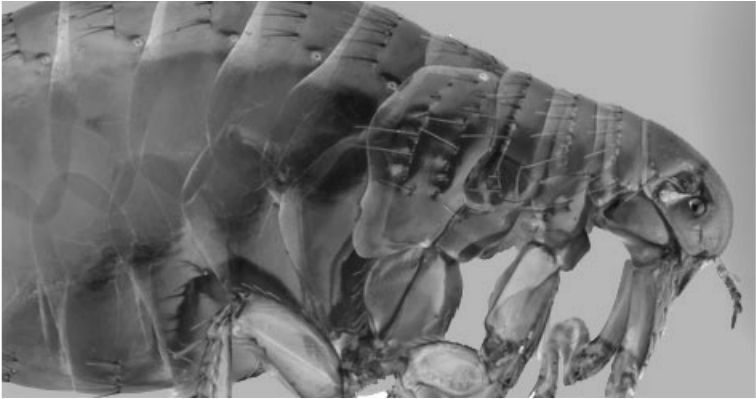MEET YOUR OPPONENT............. A.K.A. the ' FLEA'
Fleas can be recognised by the following features:
|
|
Fleas are small, wingless insects ranging in size from approximately 1-10 mm in length depending on the species. Almost everybody, especially those with cats or dogs will be familiar with these small biting insects and will have either seen them or the effects of their nuisance bites.
Dogs and cats often get infested with fleas through contact with other animals or contact with fleas in the environment. The strong back legs of this insect enable it to jump from host to host or from the environment onto the host. (Fleas do not have wings, so they cannot fly!) The flea’s bite can cause itching for the host but for a sensitive or flea-allergic animal, this itching can be quite severe and leads to hair-loss, inflammation and secondary skin infections. Some pets, hypersensitive to the flea's saliva, will itch all over from the bite of even a single flea!
Dogs and cats often get infested with fleas through contact with other animals or contact with fleas in the environment. The strong back legs of this insect enable it to jump from host to host or from the environment onto the host. (Fleas do not have wings, so they cannot fly!) The flea’s bite can cause itching for the host but for a sensitive or flea-allergic animal, this itching can be quite severe and leads to hair-loss, inflammation and secondary skin infections. Some pets, hypersensitive to the flea's saliva, will itch all over from the bite of even a single flea!
QUICK FLEA FACTS!
>> The life cycle of a flea consists of 4 stages, the egg, the larvae, the pupae and the adult
>> An adult female flea can lay on average 40-50 eggs PER DAY!
>> Only 5-10% of any flea population is found on your pet. Where is the rest?
>> Fleas are external parasites and not surprising, they are also very adaptable and are able to withstand unfavourable conditions.
>> Adult fleas feed on the blood of their host (commonly the family pet) and although most fleas are adapted to one particular animal, many are not host specific and will move to other animals if their preferred host is unavailable. Fleas can live for many days without food if a host is not immediately available.
>> Optimum temperatures for the flea's life cycle are
21 - 30 degrees Celsius and optimum humidity is 70%.
>> The life cycle of a flea consists of 4 stages, the egg, the larvae, the pupae and the adult
>> An adult female flea can lay on average 40-50 eggs PER DAY!
>> Only 5-10% of any flea population is found on your pet. Where is the rest?
>> Fleas are external parasites and not surprising, they are also very adaptable and are able to withstand unfavourable conditions.
>> Adult fleas feed on the blood of their host (commonly the family pet) and although most fleas are adapted to one particular animal, many are not host specific and will move to other animals if their preferred host is unavailable. Fleas can live for many days without food if a host is not immediately available.
>> Optimum temperatures for the flea's life cycle are
21 - 30 degrees Celsius and optimum humidity is 70%.
REFERENCES:
PIPER, ROSS (2007), Extraordinary Animals: An Encyclopedia of Curious and Unusual Animals, Greenwood Press
www.petmd.com/dog/care/evr_dg_fleas_on_dogs_and_what_you_can_do_about_them
PIPER, ROSS (2007), Extraordinary Animals: An Encyclopedia of Curious and Unusual Animals, Greenwood Press
www.petmd.com/dog/care/evr_dg_fleas_on_dogs_and_what_you_can_do_about_them



